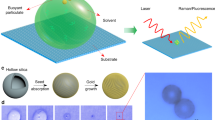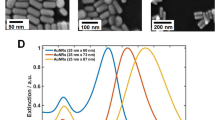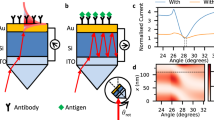Abstract
Existing methods for the optical detection of single molecules require the molecules to absorb light to produce fluorescence1 or direct absorption signals2,3,4. This limits the range of species that can be detected, because most molecules are purely refractive. Metal nanoparticles5,6 or dielectric resonators7,8,9 can be used to detect non-absorbing molecules because local changes in the refractive index produce a resonance shift. However, current approaches only detect single molecules when the resonance shift is amplified by a highly polarizable label8,10,11 or by a localized precipitation reaction on the surface of a nanoparticle12. Without such amplification, single-molecule events can only be identified in a statistical way13. Here, we report the plasmonic detection of single molecules in real time without the need for labelling or amplification. Our sensor consists of a single gold nanorod coated with biotin receptors, and the binding of single proteins is detected by monitoring the plasmon resonance of the nanorod with a sensitive photothermal assay14. The sensitivity of our device is ∼700 times higher than state-of-the-art plasmon sensors15 and is intrinsically limited by spectral diffusion of the surface plasmon resonance.
This is a preview of subscription content, access via your institution
Access options
Subscribe to this journal
Receive 12 print issues and online access
$259.00 per year
only $21.58 per issue
Buy this article
- Purchase on Springer Link
- Instant access to full article PDF
Prices may be subject to local taxes which are calculated during checkout



Similar content being viewed by others
References
Moerner, W. E. & Orrit, M. Illuminating single molecules in condensed matter. Science 283, 1670–1676 (1999).
Gaiduk, A., Yorulmaz, M., Ruijgrok, P. V. & Orrit, M. Room-temperature detection of a single molecule's absorption by photothermal contrast. Science 330, 353–356 (2010).
Chong, S., Min, W. & Xie, X. S. Ground-state depletion microscopy: detection sensitivity of single-molecule optical absorption at room temperature. J. Phys. Chem. Lett. 1, 3316–3322 (2010).
Kukura, P., Celebrano, M., Renn, A. & Sandoghdar, V. Single-molecule sensitivity in optical absorption at room temperature. J. Phys. Chem. Lett. 1, 3323–3327 (2010).
Anker, J. N. et al. Biosensing with plasmonic nanosensors. Nature Mater. 7, 442–453 (2008).
Mayer, K. M. & Hafner, J. H. Localized surface plasmon resonance sensors. Chem. Rev. 111, 3828–3857 (2011).
Arnold, S., Khoshsima, M., Teraoka, I., Holler, S. & Vollmer, F. Shift of whispering-gallery modes in microspheres by protein adsorption. Opt. Lett. 28, 272–274 (2003).
Shopova, S. I., Rajmangal, R., Holler, S. & Arnold, S. Plasmonic enhancement of a whispering-gallery-mode biosensor for single nanoparticle detection. Appl. Phys. Lett. 98, 243104 (2011).
Lu, T. et al. High sensitivity nanoparticle detection using optical microcavities. Proc. Natl Acad. Sci. USA 108, 5976–5979 (2011).
Sönnichsen, C., Reinhard, B. M., Liphardt, J. & Alivisatos, A. P. A molecular ruler based on plasmon coupling of single gold and silver nanoparticles. Nature Biotechnol. 23, 741–745 (2005).
Sannomiya, T., Hafner, C. & Vörös, J. In situ sensing of single binding events by localized surface plasmon resonance. Nano Lett. 8, 3450–3455 (2008).
Chen, S., Svedendahl, M., Van Duyne, R. P. & Käll, M. Plasmon-enhanced colorimetric ELISA with single molecule sensitivity. Nano Lett. 11, 1826–1830 (2011).
Mayer, K. M., Hao, F., Lee, S., Nordlander, P. & Hafner, J. H. A single molecule immunoassay by localized surface plasmon resonance. Nanotechnology 21, 255503 (2010).
Boyer, D., Tamarat, P., Maali, A., Lounis, B. & Orrit, M. Photothermal imaging of nanometer-sized metal particles among scatterers. Science 297, 1160–1163 (2002).
Nusz, G. J., Curry, A. C., Marinakos, S. M., Wax, A. & Chilkoti, A. Rational selection of gold nanorod geometry for label-free plasmonic biosensors. ACS Nano 3, 795–806 (2009).
Nie, S. M. & Emory, S. R. Single-molecule detection and spectroscopy by surface-enhanced Raman scattering. Science 275, 1102–1106 (1997).
Kneipp, K. et al. Single molecule detection using surface-enhanced Raman scattering (SERS). Phys. Rev. Lett. 78, 1667–1670 (1997).
Xu, H. X., Bjerneld, E. J., Käll, M. & Börjesson, L. Spectroscopy of single hemoglobin molecules by surface enhanced Raman scattering. Phys. Rev. Lett. 83, 4357–4360 (1999).
Stiles, P. L., Dieringer, J. A., Shah, N. C. & Van Duyne, R. P. Surface-enhanced Raman spectroscopy. Annu. Rev. Anal. Chem. 1, 601–626 (2008).
Etchegoin, P. G. & Le Ru, E. C. A perspective on single molecule SERS: current status and future challenges. Phys. Chem. Chem. Phys. 10, 6079–6089 (2008).
Liu, M. Z., Guyot-Sionnest, P., Lee, T. W. & Gray, S. K. Optical properties of rodlike and bipyramidal gold nanoparticles from three-dimensional computations. Phys. Rev. B 76, 235428 (2007).
Jana, N. R. Gram-scale synthesis of soluble, near-monodisperse gold nanorods and other anisotropic nanoparticles. Small 1, 875–882 (2005).
Zijlstra, P., Bullen, C., Chon, J. W. M. & Gu, M. High-temperature seedless synthesis of gold nanorods. J. Phys. Chem. B 110, 19315–19318 (2006).
Berciaud, S., Cognet, L., Blab, G. A. & Lounis, B. Photothermal heterodyne imaging of individual nonfluorescent nanoclusters and nanocrystals. Phys. Rev. Lett. 93, 257402 (2004).
Vörös, J. The density and refractive index of adsorbing protein layers. Biophys. J. 87, 553–561 (2004).
Kerssemakers, J. W. J. et al. Assembly dynamics of microtubules at molecular resolution. Nature 442, 709–712 (2006).
Yurkin, M. A. & Hoekstra, A. G. The discrete-dipole-approximation code ADDA: capabilities and known limitations. J. Quant. Spectrosc. Radiat. Transf. 112, 2234–2247 (2011).
Weber, P. C., Ohlendorf, D. H., Wendoloski, J. J. & Salemme, F. R. Structural origins of high-affinity biotin binding to streptavidin. Science 243, 85–88 (1989).
González, M., Argarana, C. E. & Fidelio, G. D. Extremely high thermal stability of streptavidin and avidin upon biotin binding. Biomol. Eng. 16, 67–72 (1999).
Robertson, A. D. & Murphy, K. P. Protein structure and the energetics of protein stability. Chem. Rev. 97, 1251–1267 (1997).
Ament, I., Prasad, J., Henkel, A., Schmachtel, S. & Sönnichsen, C. Single unlabeled protein detection on individual plasmonic nanoparticles. Nano Lett. 12, 1092–1095 (2012).
Nikoobakht, B. & El-Sayed, M. A. Preparation and growth mechanism of gold nanorods (NRs) using seed-mediated growth method. Chem. Mater. 15, 1957–1962 (2003).
Acknowledgements
The authors thank P.V. Ruijgrok and H. van der Meer for help with the experimental set-up. P.Z. and M.O. acknowledge financial support from the European Research Council (Advanced Grant SiMoSoMa). P.Z. acknowledges financial support from the Netherlands Organisation for Scientific Research (Veni Fellowship). P.M.R.P. acknowledges financial support from Program Ciência 2008 from Fundação para a Ciência e a Tecnologia.
Author information
Authors and Affiliations
Contributions
P.Z. and M.O. designed the optical experiments. P.Z. and P.M.R.P. developed the procedure for tip functionalization. P.Z. performed the optical experiments. P.M.R.P. performed the calculations. P.Z, P.M.R.P. and M.O. analysed the data and wrote the manuscript.
Corresponding author
Ethics declarations
Competing interests
The authors declare no competing financial interests.
Supplementary information
Supplementary information
Supplementary information (PDF 4127 kb)
Rights and permissions
About this article
Cite this article
Zijlstra, P., Paulo, P. & Orrit, M. Optical detection of single non-absorbing molecules using the surface plasmon resonance of a gold nanorod. Nature Nanotech 7, 379–382 (2012). https://doi.org/10.1038/nnano.2012.51
Received:
Accepted:
Published:
Issue Date:
DOI: https://doi.org/10.1038/nnano.2012.51
This article is cited by
-
Submonolayer biolasers for ultrasensitive biomarker detection
Light: Science & Applications (2023)
-
Demonstration of intracellular real-time molecular quantification via FRET-enhanced optical microcavity
Nature Communications (2022)
-
Ultraviolet optical horn antennas for label-free detection of single proteins
Nature Communications (2022)
-
Evanescent scattering imaging of single protein binding kinetics and DNA conformation changes
Nature Communications (2022)
-
Modelling of the dynamic polarizability of macromolecules for single-molecule optical biosensing
Scientific Reports (2022)



